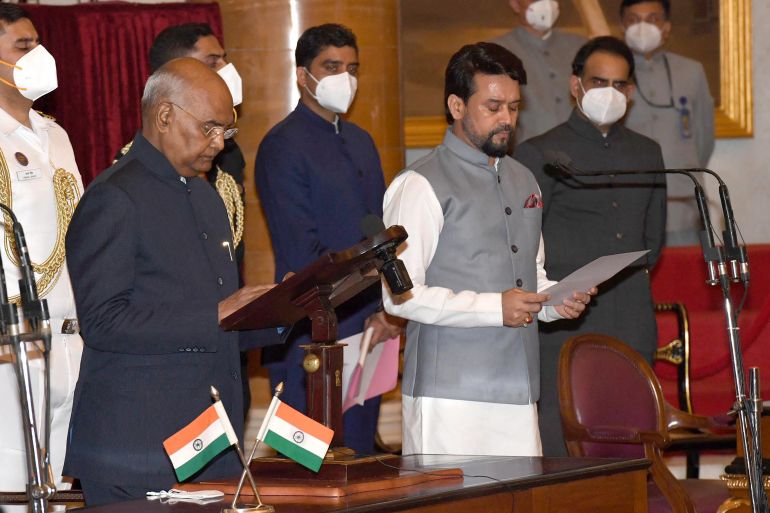India gets new ministers for health, IT, oil amid COVID crisis
India’s PM Narendra Modi drops 12 senior ministers and inducts a younger team aimed at refurbishing his government’s image.

Indian Prime Minister Narendra Modi has appointed new federal ministers for health, IT and oil as part of a reshuffle aimed at refurbishing his government’s image amid fierce criticism of its handling of the coronavirus pandemic.
Modi appointed Mansukh Laxman Mandaviya as the country’s new health minister just hours after Harsh Vardhan, who was the face of the government’s efforts to fight COVID-19, was asked to step down along with his deputy.
Keep reading
list of 4 itemsWhy did India open a backchannel to the Taliban?
UN ‘disturbed’ by death of Indian activist Stan Swamy in jail
With 2% convictions, India’s terror law more a ‘political weapon’
Official sources said Vardhan had to pay the political price for the government’s struggles to cope with a devastating second wave of coronavirus infections.
Modi’s government has faced sharp criticism for the chaotic rollout of a nationwide immunisation campaign that experts said had worsened the impact of the second wave, killing hundreds of thousands.
The official death toll after a surge in COVID-19 infections in April and May passed 400,000 last week.
More than half of those reported deaths – the third most of any country – occurred during the past two months as the Delta variant of the virus tore through the nation and overwhelmed its already strained healthcare system.
Experts believe the actual number may be much higher and there are fears of a third wave soon. Millions remain unvaccinated.
Mandaviya, who belongs to Modi’s home state Gujarat, was previously a junior minister holding the portfolios for ports and chemicals and fertilisers.
‘Buck actually stops with PM’
Opposition leader P Chidambaram said the removal of the health minister and his deputy was an acknowledgement that the Modi government had failed in managing the pandemic but the buck should stop with Modi.
“There is a lesson for ministers in these resignations. If things go right the credit will go to the PM, if things go wrong the minister will be the fall guy,” he said.
The reshuffle also came after the defeat of Modi’s Hindu nationalist Bharatiya Janata Party (BJP) in April elections in the key West Bengal state.
“If it was really about the COVID-19 mismanagement, was [Vardhan] solely responsible? Definitely not,” Rijo M John, health economist and a professor at the Rajagiri College of Social Sciences in the southern city of Kochi, said on Twitter.
“The buck actually stops with the PM himself,” John said.
I congratulate all the colleagues who have taken oath today and wish them the very best for their ministerial tenure. We will continue working to fulfil aspirations of the people and build a strong and prosperous India. #Govt4Growth pic.twitter.com/AVz9vL77bO
— Narendra Modi (@narendramodi) July 7, 2021
In all, 15 cabinet ministers and 28 junior ministers were sworn in by President Ram Nath Kovind at a ceremony in the presidential palace on Wednesday.
They replace 12 ministers that were fired in the first cabinet reshuffle since Modi was re-elected in 2019 on a promise to transform India into a political and economic power.
Eight junior ministers were elevated to the cabinet rank.
Modi retained Home Minister Amit Shah, Defence Minister Rajnath Singh, Finance Minister Nirmala Sitharaman and External Affairs Minister Subrahmanyam Jaishankar.
IT minister sacked amid Twitter spat
Modi appointed Ashwini Vaishnaw as the new information and technology minister after dismissing Ravi Shankar Prasad at a time when he was leading the government’s efforts to persuade US social media giants to comply with the laws of the country.
No reasons were provided for Prasad’s dismissal, although an industry source familiar with the thinking of Facebook, WhatsApp and Twitter expected them to welcome the change at the ministry.
“A reset always helps,” said the source. “It so far appeared there was lack of conversation.”
Amid high fuel prices, Hardeep Singh Puri has been appointed oil minister, replacing Dharmendra Pradhan.
Modi also dropped Information and Broadcasting Minister Prakash Javadekar, who was also the government’s spokesman.
He retained his core team at the foreign, finance, home and defence departments even though the economy is in a deep recession and there are widespread concerns that a surge in COVID-19 infections will stall economic recovery.
“The larger implication is that the confidence that the Modi government had was shaken by the COVID-19 second wave,” said political commentator Rasheed Kidwai. “Modi is trying to introduce a new work culture by these changes.”
Modi will face another major test of his popularity in state elections in Uttar Pradesh, Goa, Manipur, Punjab and Uttarakhand states in February and March next year, which may prove to be a bellwether for his party in 2024 national elections.